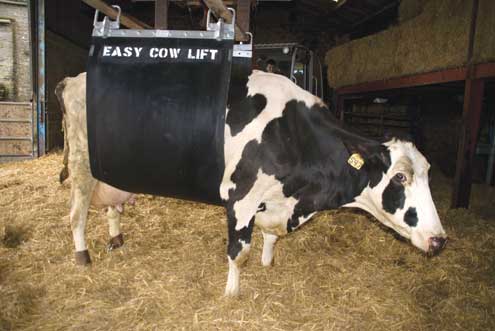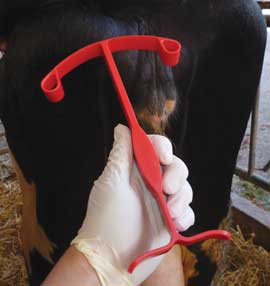Livestock technology to look out for in 2013

Easy cow lift
Downer cows can now be lifted simply and humanely, thanks to a new farmer-designed aid.
The Easy Cow Lift (pictured above) helps lift downer cows using pallet forks from any direction – but ideally from the front, as you can alter the angle of the forks to gain the right amount of weight on the rear legs. It also allows the cow to be left in the raised position for long periods, helping her to recover confidence and circulation. Cows can be moved from shed to shed and the Easy Cow Lift is easily removed when the cow stands.
The innovative design won the best new product award at AgriScot 2012.
Pig oestrus detection
A new pig oestrus detection system developed for sows in group housing offers reliable and stress-free detection, says its maker.
SowCheck, from manufacturer Big Dutchman, has been developed especially for sows in group housing with electronic sow feeding stations, as well as for sows in free-movement pens.
The analysis and automatic selection are carried out while the sow visits the feeding station. Two lateral rolls move along the flanks of the sow and another roll stimulates the boar’s breast from above. At the same time, the sow has direct optical, acoustic and olfactory contact with the boar through an opening connecting with the boar pen on the other side.
Ruminant monitor
A health monitoring system for ruminants could highlight digestive disturbance in an individual animal before visible symptoms appear.
The RumiWatch system, which consists of a halter, pedometer and evaluation software, measures ruminating, feeding and water uptake activity, as well as locomotion and rest behaviour, and then transfers the data to a PC without a cable.
The system monitors key parameters relevant to the health of the cows. For example, by identifying a reduced number of chewing motions it is possible to conclude digestive disturbances or faults in the ration.
 Birth aid
Birth aid
The iVET birth monitor for cattle consists of a transmitter-and-receiver system. The flexible T-shaped sensor is inserted into the cow’s vagina. At the start of birth the sensor is pressed out by the amniotic sac and the calf. The change in position of the system is registered by the light and temperature sensor and a signal is sent by voice message and text message to two preprogrammed mobile telephone numbers to alert a farmer to the start of calving.
iVET additionally monitors the body temperature and can identify pathological changes in the cow at an early stage.
Selecting for disease resistance
A new genetic technology will enable dairy farmers to select sires for greater immunity and disease resistance.
Semex has launched a range of proven and genomic sires identified as having high immunity under a new Immunity+ brand in the December proofs.
At the core of this latest genetic breakthrough is High Immune Response (HIR) technology, which identifies cows with different levels of immune response to diseases such as mastitis, metritis, ketosis, retained placenta and Johne’s disease.
High Immune Responder cows (HIRs) have disease levels that are two to four times lower than those that are Low Immune Responders (LIRs), with the HIRs requiring less therapeutic intervention as a result. About 10% of bulls are believed to have genes classed as HIRs.
Four-way milking cluster
A four-way milking cluster has been designed to keep the milk delivered from each quarter separate until it enters the milk line.
The IQ cluster from GEA Technologies prevents milk from one quarter being able to reach the tip of the teat in another quarter and ensures there is no cross contamination.
Other features include a system that only activates the full vacuum once the milking cup has been attached to the teat and, when milking, the vacuum in the cluster is said to remain stable, even under high milk flows.
Keep up to date with all the latest new products with our new products page
